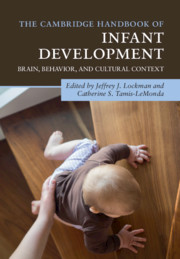Book contents
- The Cambridge Handbook of Infant Development
- The Cambridge Handbook of Infant Development
- Copyright page
- Dedication
- Contents
- Illustrations
- Contributors
- Preface
- Part I Foundations
- 1 Embodied Brain Model for Understanding Functional Neural Development of Fetuses and Infants
- 2 Infant Physical Growth
- 3 Dynamic Epigenetic Impact of the Environment on the Developing Brain
- 4 Brain Development in Infants
- 5 Development During Infancy in Children Later Diagnosed with Autism Spectrum Disorder
- Part II Perceptual Development
- Part III Cognitive Development
- Part IV Action
- Part V Language
- Part VI Emotional and Social Development
- Index
- References
1 - Embodied Brain Model for Understanding Functional Neural Development of Fetuses and Infants
from Part I - Foundations
Published online by Cambridge University Press: 26 September 2020
- The Cambridge Handbook of Infant Development
- The Cambridge Handbook of Infant Development
- Copyright page
- Dedication
- Contents
- Illustrations
- Contributors
- Preface
- Part I Foundations
- 1 Embodied Brain Model for Understanding Functional Neural Development of Fetuses and Infants
- 2 Infant Physical Growth
- 3 Dynamic Epigenetic Impact of the Environment on the Developing Brain
- 4 Brain Development in Infants
- 5 Development During Infancy in Children Later Diagnosed with Autism Spectrum Disorder
- Part II Perceptual Development
- Part III Cognitive Development
- Part IV Action
- Part V Language
- Part VI Emotional and Social Development
- Index
- References
Summary
Early functional neural development is increasingly recognized as important for revealing the developmental origins of human cognitive-motor function and related disorders. Previous studies focusing on fetuses and neonates have revealed sophisticated behaviors and cognitive repertoires, indicating that fetuses begin learning through sensorimotor experience even inside the uterus. Despite accumulating evidence supporting the importance of sensorimotor experience in neural development as early as the fetal period, the developmental mechanisms by which intrauterine sensorimotor experience guides cortical learning, including factors in prenatal experience that are needed for normal development, remain unclear. However, investigating causal links between sensorimotor experience and cortical learning is particularly challenging in human fetuses owing to technical and ethical difficulties. Therefore, computational approaches based on comprehensive biological data about nervous system, body, and environment have been developed to probe mechanisms underlying early functional brain development. In this chapter, we show how an embodied approach focusing on interactions among brain, body, and environment offers opportunities to explore relations between functional neural development and sensorimotor experience.
- Type
- Chapter
- Information
- The Cambridge Handbook of Infant DevelopmentBrain, Behavior, and Cultural Context, pp. 3 - 39Publisher: Cambridge University PressPrint publication year: 2020

